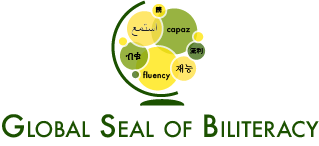December
GLOBAL CLASSROOM PAIR – SHARE - What does it look like?
The Global Seal will be pairing classrooms around the world to provide language learners with an opportunity to use their growing language skills to learn about one another and to work together as global citizens to create shared projects.
Partnered educators will plan their activities and organize their collaboration. If possible, students from collaborating schools (with their teachers), organize online meetings to create project products synchronously. If the time difference makes it impossible to meet, the activities are designed so that paired classrooms can work asynchronously as well.
In addition to each month's theme-related Content Goals, we have included Language Goals. Use "Content Goals" to engage the interest of your language learners, while intentionally thinking about "Language Goals" or how the tasks will also build and grow language proficiency.
It is important that paired classrooms document their projects. Take pictures during meetings or when your students are carrying out the tasks. Add a post to our Facebook page - show others how you are doing! It will be inspirational and motivating for others!
Explore our technology resources list to support your creative project ideas.
Please remember to protect the privacy of your students. Do not share their full names or other identifying information. Be sure you have permission if you share student images or likenesses.
December GOALS & ACTIVITIES
December’s Theme: “2023, Here we come!”
December’s Goal: The goal for our third and final month is the future and new beginnings. Thinking “big picture” about global citizenship and “small snapshot” of individual growth to meet personal goals, encourage students to think about the power of one and the positive contributions they can make.
SHARE – Paired Classroom Activity
Students can opt to investigate a young “global citizen.” Help learners identify young people with big ideas and dreams that they have worked to make reality. This is an opportunity to learn content vocabulary on global issues. Students can collaborate with their Paired Classroom(s) to discuss a common issue they have in common. Here are examples of young changemakers: https://www.waterford.org/education/kids-who-changed-the-world/
Collaboratively, the Paired Classrooms can create a “New Year’s Playlist.” Challenge students to create a playlist that captures a mood. It could be celebratory, reflective, or inspirational. The playlist should include songs from each country or culture. Aim for 10-20 songs and have students write an introduction to each song and give their new playlist a title. Invite them to share their playlist with others.
COMPARE– Paired Classroom Activity
How is the New Year celebrated around the world? Classrooms can choose to do some research to find out. Ask students to investigate the New Year's Eve traditions of their own country and that of and their Paired Classroom(s) and then have a discussion to compare and contrast. For example, in Spain, many eat 12 grapes at midnight to ensure 12 lucky months ahead. In the Philippines, some bang pots and pans to scare away evil spirits. Students can also compare special foods or traditions and their meaning. Are they hoping for wealth, good luck, a long life, or a fresh start?
Each classroom can share their country’s traditions on our digital map by placing a push pin and comment on a world map.
Advanced students can write a paragraph to compare and contrast New Year’s traditions in two countries. Or, have them compare their family's traditions with those in another country. Compare what they have in common and contrast what is different. A Venn Diagram product is a visual way to share their results.
PREPARE
As a class prepare a digital “Time Capsule” to reflect on the events and activities of 2022 in your country. Find 10 items to include. These could be important events, famous people, sports, media or entertainment. Share your “time capsule” with your Paired Classroom” and share why each item was included. This can be a simple shared Google folder, an infograph, or graphic organizer. There are even time capsule Apps available.
DECLARE
Selecting this option means that your students’ wishes will be added to the confetti that flutters down in New York City’s Time Square on New Year’s Eve! Each year, people from around the planet include their wishes for the New Year on pieces of official Times Square New Year’s Eve confetti. Students can add a personal goal, a dream for the future, or just something they want to do for the very first time. On New Year’s Eve, they can watch their wishes fly! To document, your students can take a screenshot of their wish (do not include their name on the left in the screenshot). To participate, all wishes must be submitted by December 25th using this link:
https://www.timessquarenyc.org/whats-happening/nye-wishing-wall#wish
4,000 years ago, the ancient Babylonians are said to have made the first New Year’s resolutions. They promised to pay off their debts and return borrowed items. Today, many people focus on self-improvement such as breaking a bad habit or learning a new skill like speaking a new language. This option asks students to declare (1) one thing they would like to try, (2) one thing they want to become better at, and (3) one way in which they could make the world a better place. (Think about kindness, service, environment, etc.) Students can complete a presentation, video or graphic organizer to declare their intentions. More advanced learners might include what steps they will take to ensure they stick to their goals.
DARE
With your Paired Classroom(s), dare to identify a mutually shared problem and create a plan to begin solving it. It would be truly exciting to see your classes implement all or part of the plan in 2023!
Language Goals for December – This focus of this month’s language tasks are time frames, especially those that include future concepts. For novice level language learners, this could be a simple construction, “I am going to…” or “I hope/plan to…”, but you can also teach a future verb form, “I will…”. To practice language time frames, you can include “last year, I…, but next year I will…” For example, if you chose to investigate a youth hero, you can use the past to describe what the person accomplished. For more advanced learners, you can add conjecture, conditional “I might…”, or a hypothetical, “I could…”, or “I would...”
As a caution, you may need to teach language learners the subtle differences between these three words often used in New Years discussion: resolution, prediction, and wish. Some options allow you to explore global challenges, which address the SDGoals, and offer students rich vocabulary learning opportunities. For Advanced Placement (AP) and International Baccalaureate (IB) language classrooms these topics align well with your course themes.
Click here to review our netiquette policies.






